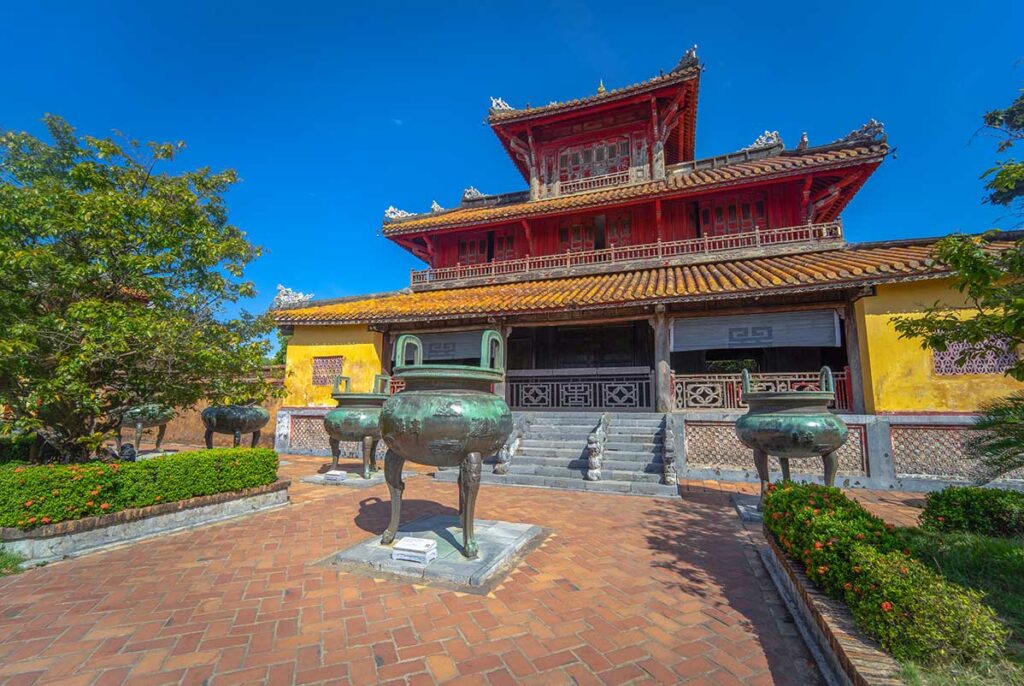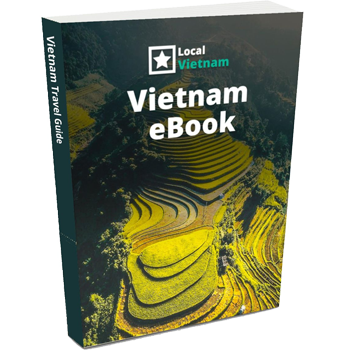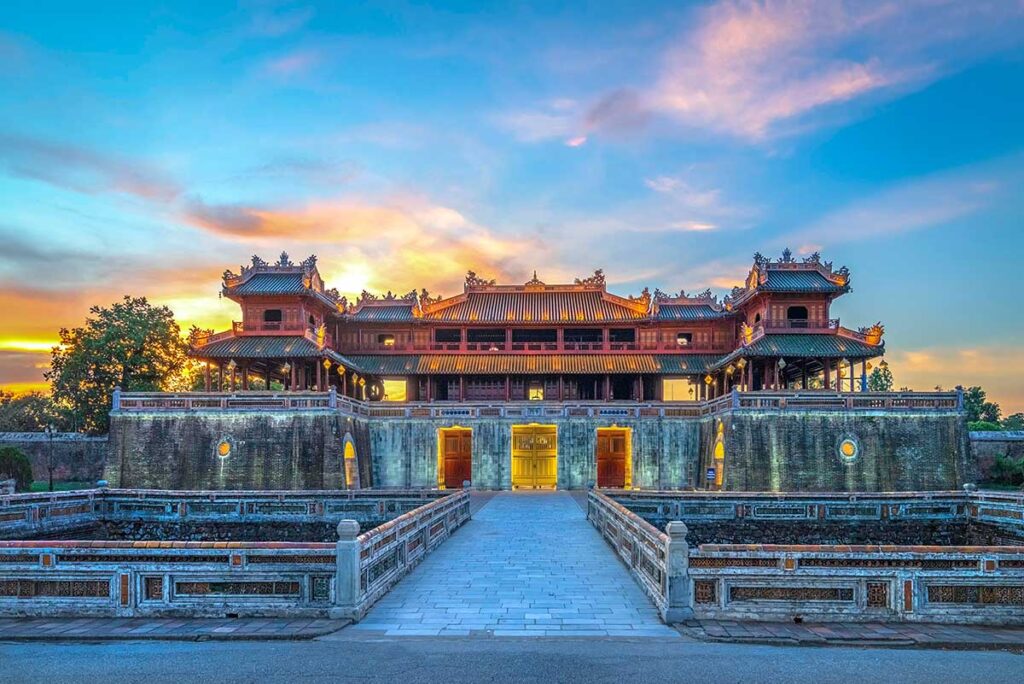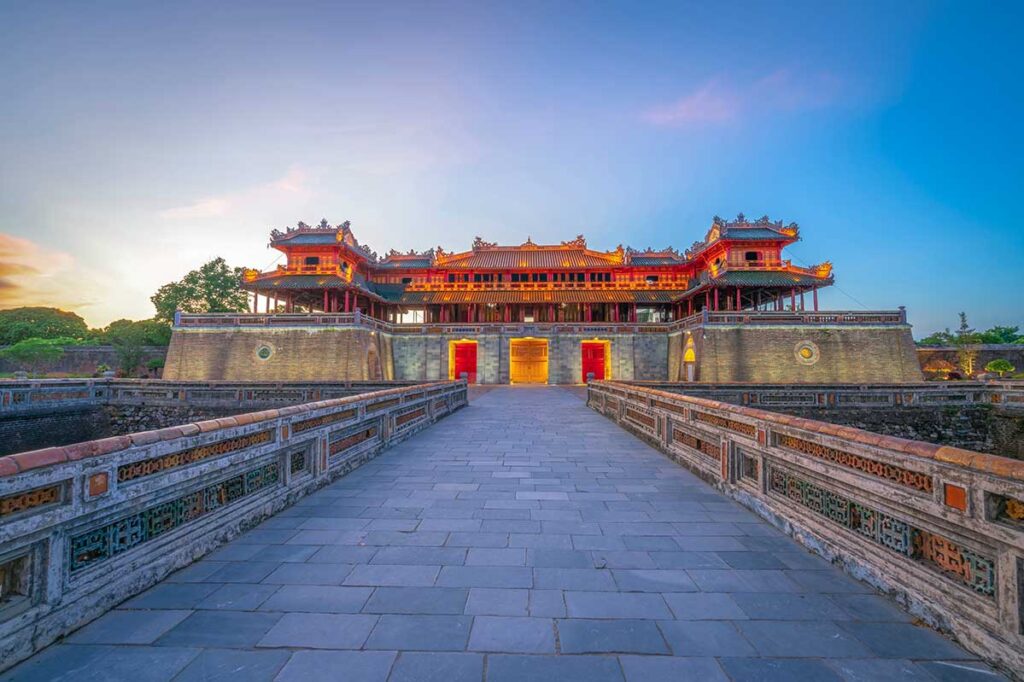What are the Nine Dynastic Urns?
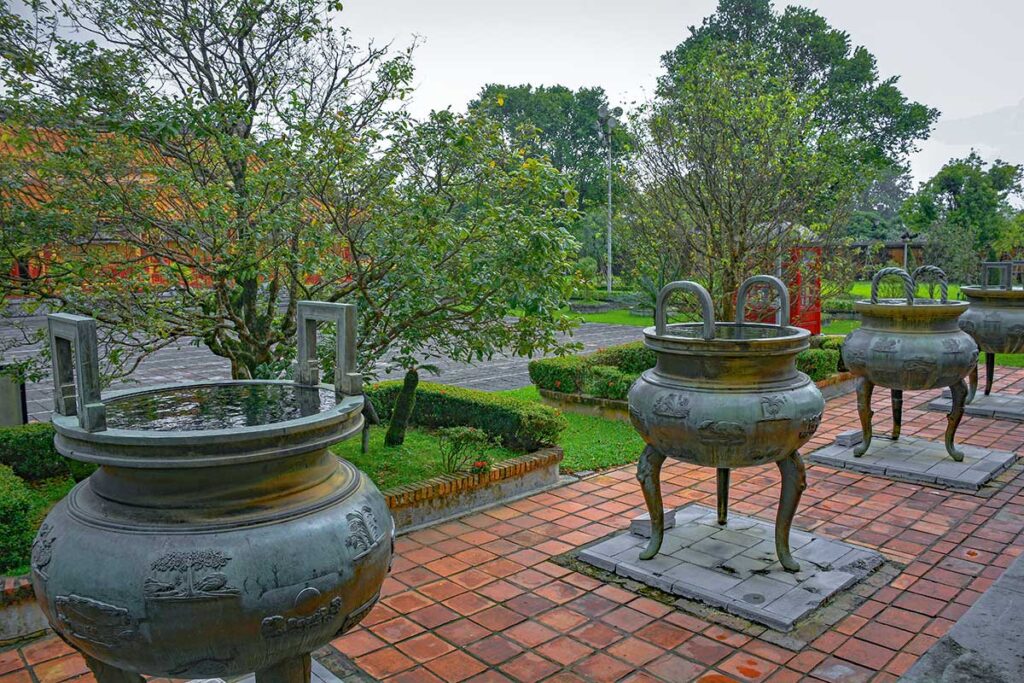
The Nine Dynastic Urns (Cửu Đỉnh) are a set of bronze urns arranged in the courtyard of The Mieu Temple, within the To Mieu Temple Complex of Hue’s Imperial City. Cast between 1835 and 1837 under Emperor Minh Mang, they were created to honor the emperors of the Nguyen Dynasty and to embody the dynasty’s enduring power and unity. Each urn is decorated with detailed reliefs of Vietnam’s geography, plants, animals, and cultural symbols, offering a visual snapshot of the nation during the 19th century.
History of the Nine Dynastic Urns
The Nine Dynastic Urns were commissioned by Emperor Minh Mang during the height of the Nguyen Dynasty, a period marked by political stability and territorial unity. Cast between 1835 and 1837, they were made of bronze—then one of the most prestigious and enduring materials—both for its durability and symbolic value. Their design was partly inspired by the legendary nine urns of ancient Chinese dynasties, long regarded in Confucian tradition as emblems of supreme authority and rightful rule.
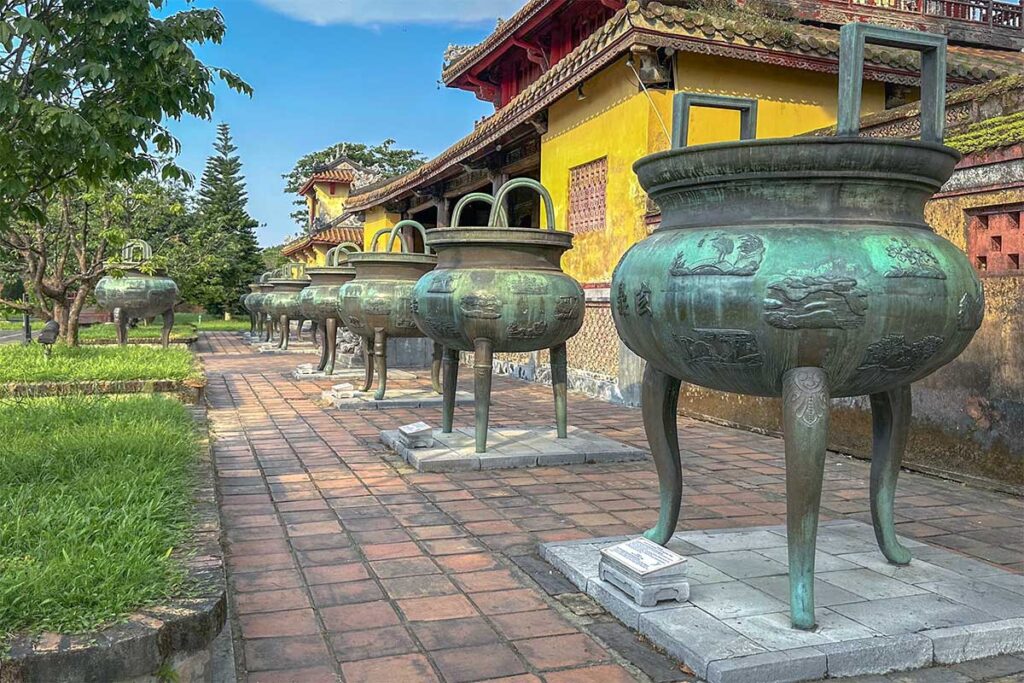
Each urn was named after the posthumous title of a Nguyen emperor, beginning with Gia Long, the dynasty’s founder. The intricate imagery carved into their surfaces represents Vietnam’s mountains, rivers, islands, animals, and cultural motifs, serving as a proud statement of sovereignty over the entire nation, including the Hoang Sa (Paracel) and Truong Sa (Spratly) archipelagos.
Despite surviving multiple wars, harsh weather, and political changes, the urns remain in their original location in front of The Mieu Temple. They were designated a National Treasure in 2012, and ongoing efforts are underway to have them recognized by UNESCO as World Documentary Heritage for their artistic, cultural, and historical significance.
Layout of the Imperial City
To better understand the location of the Nine Dynastic Urns, it helps to know how Hue’s former royal capital is arranged:
- Hue Citadel – The vast outer enclosure with defensive walls and moats, built for the protection of the royal seat.
- Imperial City – The inner compound where administrative offices, ceremonial halls, royal residences, and sacred sites were located.
- To Mieu Temple Complex – Ancestral worship area dedicated to the emperors of the Nguyen Dynasty.
The Nine Dynastic Urns are part of the To Mieu Temple Complex, standing in the courtyard between The Mieu Temple at the front and the Hien Lam Pavilion—the tallest structure in the Imperial City—directly behind them.
The Urns in detail
Arranged in a straight line in the courtyard of The Mieu Temple, the Nine Dynastic Urns reflect both the grandeur and the symbolic depth of the Nguyen Dynasty. Each one corresponds to an emperor’s altar inside the temple and together they form a bronze monument to imperial authority, unity, and Vietnam’s cultural and natural heritage.
Physical characteristics – The urns weigh between 1,935 and 2,603 kilograms and are cast in bronze using traditional techniques. Their sturdy cylindrical bodies rest on three short legs, with broad, looped handles rising from the rim. Subtle variations in the handles and base designs distinguish each urn, while their sheer size and craftsmanship convey durability and prestige.
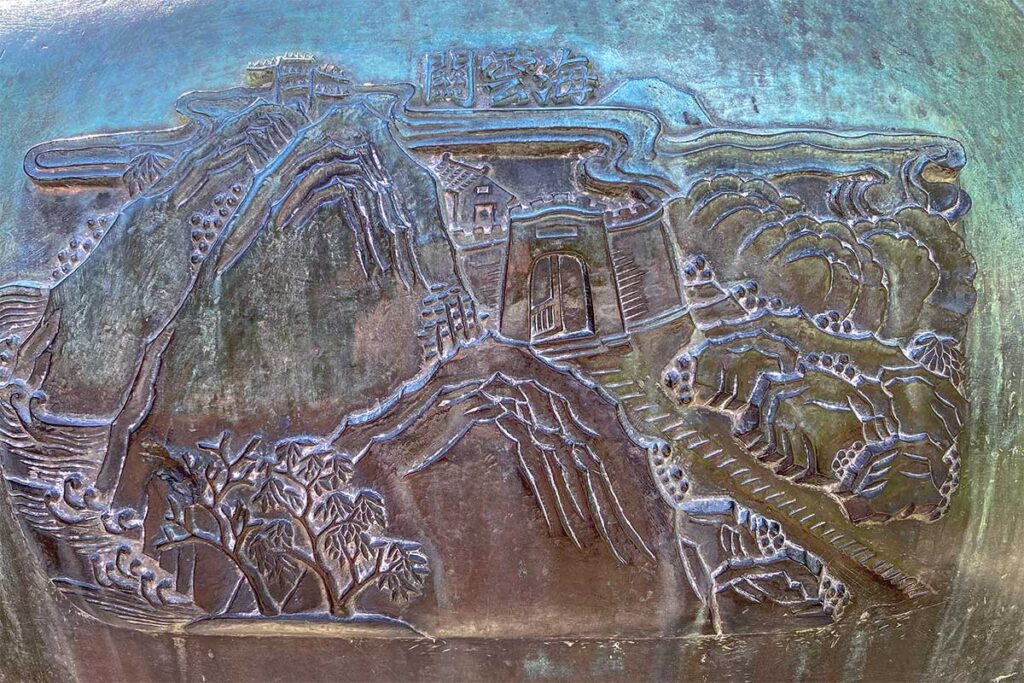
Decorative scheme – In total, there are 162 embossed images across all nine urns, with 18 images per urn arranged in three tiers. The motifs are separated by blank panels to give visual balance.
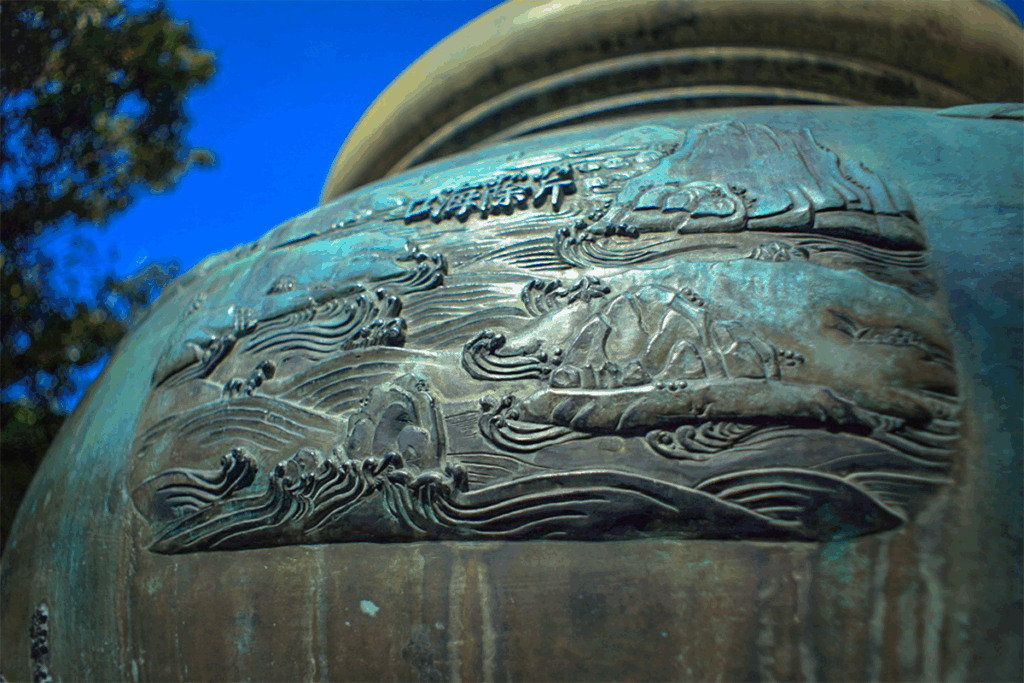
Themes in the imagery – The carvings depict Vietnam’s geography (mountains, rivers, seas), flora, fauna, cultural symbols, weapons, and vessels. These images together create a visual “encyclopedia” of the country in the early 19th century, showcasing its diversity and sovereignty. The seas and islands carved on several urns—such as the East Sea, South Sea, and West Sea—also symbolically affirm Vietnam’s maritime claims.
Symbolic meanings – In Confucian tradition, large bronze urns represent imperial legitimacy, stability, and the ruler’s connection to the land. Here, they also express the Nguyen Dynasty’s vision of a unified Vietnam, the permanence of its rule, and a deep respect for the natural world.
1. Cao Dinh – Gia Long
- Meaning of name: “High” or “lofty.”
- Corresponding emperor: Gia Long (founder of the Nguyen Dynasty).
- Weight & placement: 2,603 kg; placed at the central front position, slightly ahead of the others.
- Symbolic highlights: Images include the East Sea, the sacred dragon, and key mountains, reflecting Gia Long’s role in unifying Vietnam.
2. Nhan Dinh – Minh Mang
- Meaning of name: “Benevolence.”
- Corresponding emperor: Minh Mang.
- Weight & placement: 2,515 kg; to the left of Cao Dinh.
- Symbolic highlights: Carvings of the South Sea, agricultural crops, and national landmarks, reflecting Minh Mang’s reforms and consolidation.
3. Chuong Dinh – Thieu Tri
- Meaning of name: “Clear bell sound.”
- Corresponding emperor: Thieu Tri.
- Weight & placement: 2,099 kg; to the right of Cao Dinh.
- Symbolic highlights: Includes the West Sea, ceremonial objects, and plants associated with learning and refinement.
4. Nghi Dinh – Kien Phuc
- Meaning of name: “Righteousness.”
- Corresponding emperor: Kien Phuc.
- Weight & placement: 2,542 kg; to the right of Chuong Dinh.
- Symbolic highlights: Depicts sacred animals and rare plants, symbolizing youthful promise (Kien Phuc reigned briefly and died young).
5. Tuyen Dinh – Khai Dinh
- Meaning of name: “Proclaiming.”
- Corresponding emperor: Khai Dinh.
- Weight & placement: 2,068 kg; to the right of Nghi Dinh.
- Symbolic highlights: Features modern elements of the early 20th century alongside traditional motifs, reflecting his reign’s mix of old and new.
6. Huyen Dinh – Duy Tan
- Meaning of name: “Profound.”
- Corresponding emperor: Duy Tan.
- Weight & placement: 1,935 kg; to the right of Tuyen Dinh.
- Symbolic highlights: Imagery tied to youth and reform, echoing Duy Tan’s reformist spirit before his exile.
7. Thuan Dinh – Dong Khanh
- Meaning of name: “Obedience” or “accord.”
- Corresponding emperor: Dong Khanh.
- Weight & placement: 1,952 kg; to the left of Anh Dinh.
- Symbolic highlights: Depictions of cultural symbols and architectural forms, suggesting diplomacy and compromise during French influence.
8. Du Dinh – Ham Nghi
- Meaning of name: “Abundant.”
- Corresponding emperor: Ham Nghi.
- Weight & placement: 2,020 kg; to the left of Thuan Dinh.
- Symbolic highlights: Strong imagery of mountains, forests, and weapons, linking to Ham Nghi’s resistance against French colonization.
9. Anh Dinh – Tu Duc
- Meaning of name: “Heroic” or “bright.”
- Corresponding emperor: Tu Duc.
- Weight & placement: 2,576 kg; to the left of Nhan Dinh.
- Symbolic highlights: Rich scenes of poetry, art, and nature, reflecting Tu Duc’s scholarly and artistic legacy.
Highlights of visiting the To Mieu Temple Complex
The Nine Dynastic Urns are one of several important features within the To Mieu Temple Complex, a sacred area dedicated to the Nguyen emperors inside Hue’s Imperial City. For a deeper look at the history, layout, and traditions of this complex, see our full guide to the To Mieu Temple Complex.
Other key sights here include:
- The Mieu Temple – Houses ancestral altars for the emperors, each aligned with its corresponding urn in the courtyard.
- Hien Lam Pavilion – A three-storey wooden structure behind the urns, the tallest building in the Imperial City and a monument to Nguyen Dynasty achievements.
- Courtyard layout and ceremonial space – A broad, open courtyard connecting the temple and pavilion, used historically for imperial rites and offering clear views of the urns’ carvings.
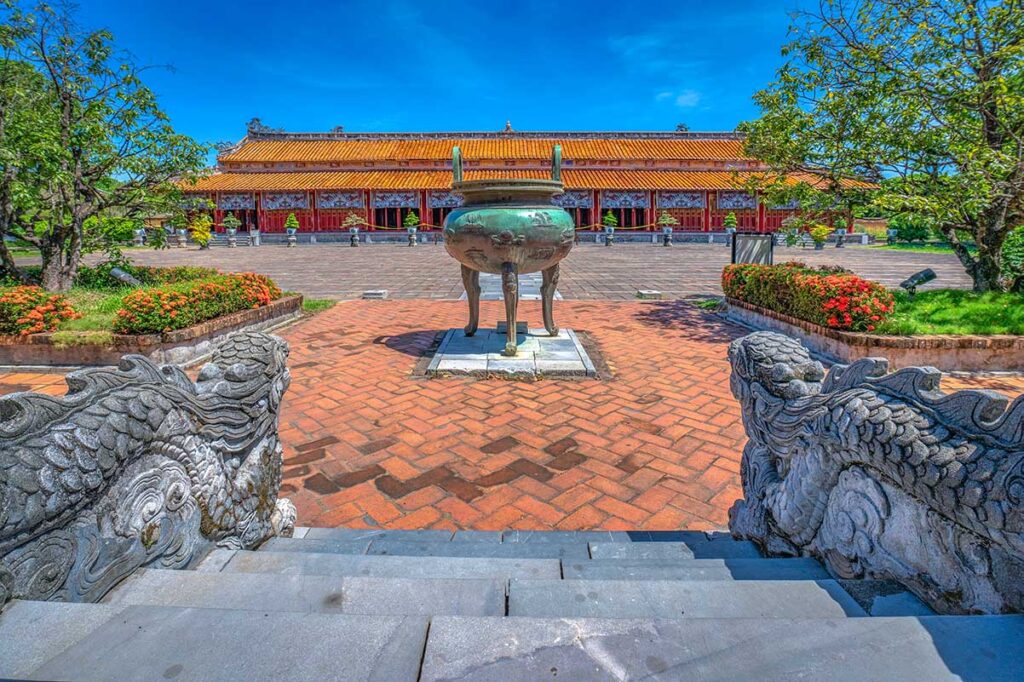
Visiting tips & What’s nearby
Tickets & Access
Entry is included with the Hue Imperial City ticket, which covers all main sites inside the complex. The Imperial City is generally open daily from morning until late afternoon, with slightly shorter hours in the rainy season.
Tip: Our full-day Hue tour covers the Imperial City, with expert guidance and seamless transfers between highlights:
Hue Historical City Tour
- Highlights: Hue Imperial City, royal tombs, Perfume River cruise, Dong Ba Market.
- Options: Small-group tour or private tour
Time Needed
Allow 10–20 minutes to view the Nine Dynastic Urns themselves, or at least half a day to explore the Imperial City in full.
Best time to visit
Early morning or late afternoon offers softer light for photography and cooler temperatures, especially in the dry season.
Nearby sights in the Imperial City
Within walking distance are Thai Binh Pavilion, Royal Theatre, Kien Trung Palace, and Thai Hoa Palace, all worth including in your visit.
Practical advice
Wear modest clothing in keeping with the site’s cultural significance. Avoid touching the bronze to help preserve the carvings, and be patient if tour groups gather around the urns—quiet moments come in between.
